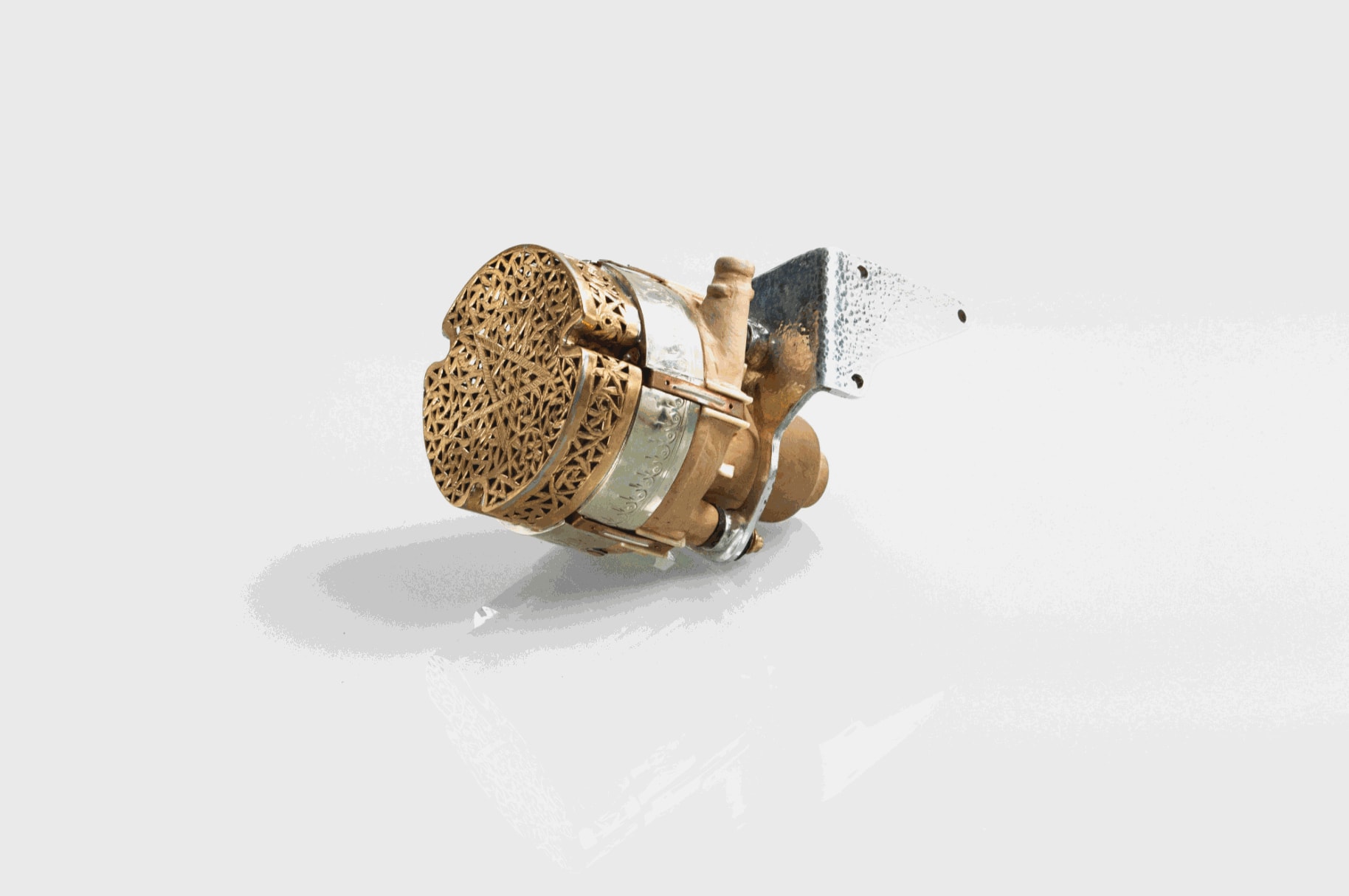
V12 Laraki Air Filter, 2013
FR dessous / NL onderaan
Eric Van Hove (Algeria, 1975) grew up in Yaoundé/Cameroon. He later studied at the École de Recherche Graphique [ERG] in Brussels and received a Master’s degree in Traditional Japanese Calligraphy at the Tokyo Gakugei University in Tokyo in 2005. He went on to obtain an artist PhD degree from the Tokyo University of the Arts in 2008 under the supervision of Kazue Kobata. As a result, his work combines western conceptual, post-colonial and Japanese non-dualist approaches and sensibilities. Furthermore, hoping to achieve a synthesis of such varied environments, his quest to succeed in creating the Total artwork (Gesamtkunst-werk) is a common thread in his work.
A metamodernist conceptual artist currently using the craft legacy as a medium to ponder the relevance of local and informal heritage in a highly globalized world economy, he often initiates large multidisciplinary collaborative productions which he refers to as « Symphonies Plastiques » (plastic symphonies), being both the composer and conductor of sculptural compositions involving dozens of people (craftsmen, engineers, etc.)
In 2012, he arrived in Marrakech, Morocco to resume work on an ambitious sculptural
endeavor he had prepared for years: V12 Laraki. Following on its acquisition by the Hood museum of Arts in 2014, the artist opened a new chapter in his creative practice and founded his atelier, also known as Fenduq or Atelier Eric van Hove: a context-specific production facility and, in his own word « a living socioeconomic sculpture », from where the artist started working on « a rethinking of contemporary art’s relationship to society in the meta-modern era » involving « a renaissance of craftmanship in the post-Fordist 21st century. »
***
Éric Van Hove (Algérie, 1975) a grandi à Yaoundé/Cameroun. Il a ensuite étudié à l'École
de Recherche Graphique [ERG] à Bruxelles et a obtenu une maîtrise en calligraphie traditionnelle traditionnelle japonaise à l'Université Tokyo Gakugei de Tokyo en 2005. Il a ensuite obtenu un doctorat d'artiste à l'Université des Arts de Tokyo en 2008 sous la direction de Kazue Kobata. En conséquence, son travail combine des approches conceptuelles occidentales, post-coloniales et japonaises non-dualistes. En outre, dans l'espoir de réaliser une synthèse d'environnements aussi variés, sa quête pour réussir à créer l'œuvre d'art totale (Gesamtkunst-werk) est un fil conducteur de son œuvre.
Un artiste conceptuel métamoderne qui utilise actuellement l'héritage artisanal comme un moyen de réfléchir à la pertinence de l'héritage local et informel dans un monde en mutation dans une économie hautement mondialisée, il initie souvent de grandes productions collaboratives multidisciplinaires qu'il appelle Symphonies Plastiques, étant à la fois le compositeur et le chef d'orchestre de compositions sculpturales impliquant des dizaines de personnes (artisans, ingénieurs, etc.).
En 2012, il est arrivé à Marrakech, au Maroc, pour reprendre le travail sur une ambitieuse œuvre sculpturale qu'il avait préparée depuis des années.
Ambitieux projet de sculpture qu'il préparait depuis des années : V12 Laraki. Suite à son acquisition par le musée des Arts de Hood en 2014, l'artiste ouvre un nouveau chapitre dans sa pratique créative et fonde son atelier, également connu sous le nom de FARAKI.
Son atelier, également connu sous le nom de Fenduq ou Atelier Eric van Hove : un lieu de « un lieu de production de l'art spécifique au contexte » et, selon ses propres mots, « une sculpture socio-économique vivante », d’où l'artiste a commencé à travailler sur « une refonte de l'art et de la culture ». L'artiste a commencé à travailler sur « une nouvelle réflexion sur la relation entre l'art contemporain et la société à l'ère méta-moderne » impliquant « une renaissance de l'artisanat dans le 21e siècle post-Fordiste ».
***
Eric Van Hove (Algerije, 1975) groeide op in Yaoundé/Kameroen. Later studeerde hij aan de École de Recherche Graphique [ERG] in Brussel en behaalde in 2005 een masterdiploma in Traditionele Japanse Kalligrafie aan de Tokyo Gakugei Universiteit in Tokio in 2005. Vervolgens behaalde hij een doctoraat als kunstenaar aan de Tokyo University of the Arts in 2008 onder de supervisie van Kazue Kobata. Als gevolg daarvan combineert zijn werk westerse conceptuele, postkoloniale en Japanse non-dualistische benaderingen en gevoeligheden. Bovendien, in de hoop een synthese te bereiken van dergelijke gevarieerde omgevingen, is zijn streven om te slagen in het creëren van het totale kunstwerk (Gesamtkunst-werk) een rode draad in zijn werk.
Een metamodernistische conceptuele kunstenaar die momenteel het ambachtelijke erfgoed gebruikt als medium om na te denken over de relevantie van lokaal en informeel erfgoed in een sterk geglobaliseerde wereldeconomie, initieert hij vaak grote multidisciplinaire samenwerkingsproducties die hij « Symphonies Plastiques » noemt (plastische symfonieën), waarbij hij zowel componist als dirigent is van sculpturale composities waarbij tientallen mensen betrokken zijn (ambachtslieden, ingenieurs, enz.).
In 2012 kwam hij aan in Marrakech, Marokko, om verder te werken aan een ambitieuze sculpturale onderneming die hij al jaren voorbereidde: V12 Laraki. Na de aankoop ervan door het Hood Museum of Arts in 2014, opende de kunstenaar een nieuw hoofdstuk in zijn creatieve praktijk en richtte zijn atelier, ook bekend als Fenduq of Atelier Eric van Hove: een context-specifieke productie en, in zijn eigen woorden « een levende socio-economische sculptuur », van waaruit de kunstenaar begon werken aan een heroverweging van de relatie van hedendaagse kunst tot de maatschappij in het meta-moderne tijdperk « een renaissance van het vakmanschap in de postfordistische 21ste eeuw. »